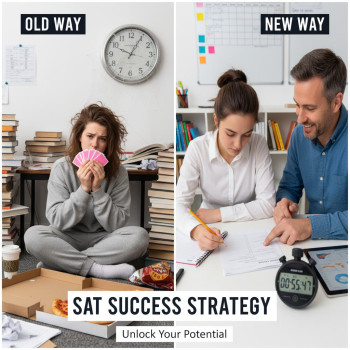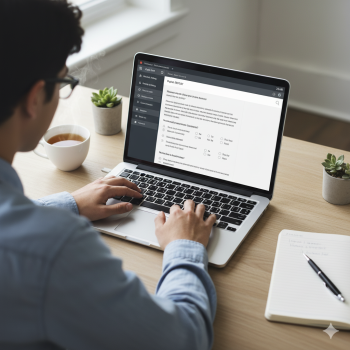Why combining SAT prep with online practice is the smartest strategy
If you’re getting ready for the Digital SAT, you might feel pulled in two directions: cover content (vocab, algebra, passage analysis) and get comfortable with the digital test format. The truth is, you don’t need to choose — combining focused study with regular online practice is the fastest and most confidence-building route. Think of content study as learning the language of the test; online practice is speaking and listening in real time.
This blog walks you through a clear, student-friendly plan to harmonize those two pieces. I’ll give you concrete routines, sample weekly schedules, tips for interpreting practice results, and ways to keep momentum without burning out. Where it fits naturally, I’ll mention how Sparkl’s personalized tutoring (1-on-1 guidance, tailored study plans, expert tutors, and AI-driven insights) can plug into this plan if you want extra help. But the core approach works whether you tutor or self-study.
Understand the anatomy of the Digital SAT before you plan
Before you design any study plan, know the shape of the test you’re training for. The Digital SAT is shorter than the old paper test, adaptive in sections, and has built-in tools like an on-screen calculator for certain math items. The types of questions — evidence-based reading and writing, and math (with calculator allowed in many questions) — remain familiar, but the digital environment changes pacing and navigation.
Why this matters: the same content knowledge is tested, but your strategy must include familiarizing your eyes, hands, and timing with a screen-based experience. That’s where online practice platforms, especially official digital practice tests, become essential.
What to practice online — and what to do offline
- Online practice (digital platform): full-length adaptive practice tests, question banks that simulate the interface, timed sections, built-in review of answers, and analytics dashboards.
- Offline study (paper or note-taking): deep review of problem types, handwriting math work, building vocabulary and grammar intuition, and writing outlines for evidence-based reading passages.
Combining these lets you separate skill-building from test execution: learn hard things slowly offline, then stress-test them online under realistic conditions.
How to start: the first 2-week audit and plan
Start with a short audit period so your plan fits you, not the other way around. Spend two weeks doing three things: baseline practice test, targeted review, and a realistic schedule. This audit reveals weak areas, timing issues, and the best ways to use practice platforms.
Week 0–1: Take a baseline digital practice test
Pick a full-length digital practice test on the official practice app or platform that mirrors test-day conditions. Treat it like a rehearsal: no notes, timed, and try the real tools (calculator, highlighting, answer flagging).
- Record raw data: total score, section scores, timing per section, and question types missed (algebra, interpreting graphs, evidence questions, sentence structure, etc.).
- Emotion check: how did the digital environment feel? Did you misclick? Did long passages feel more tiring on screen?
Week 1–2: Build a targeted study plan
Use the baseline to craft a 6–10 week plan. The trick is to alternate focused study (content mastery) and platform practice (timing & interface). A simple rule: after three content sessions on one skill, test that skill on the platform.
| Goal | When | Activity | How to Measure |
|---|---|---|---|
| Improve algebra accuracy | Weeks 1–4 | Daily focused problem sets, weekly quiz on platform | % correct on algebra items, time per question |
| Build passage reading speed | Weeks 2–6 | Timed passage drills, summary practice offline | Seconds per question, comprehension error rate |
| Digital stamina & navigation | Ongoing | Biweekly full-length digital practice tests | Consistency of scores, fewer interface mistakes |
This table becomes the heart of your study log. Update it weekly and use the platform analytics to quantify progress.
Weekly routine that blends study and online practice
Here’s a sustainable weekly template that balances deep study with practice platform use. Customize it to your schedule — but keep the rhythm of focused study followed by a practice check.
Sample weekly schedule (10–12 hours/week)
- Monday: 60–90 minutes — Targeted content lesson (math or grammar) + practice problems (offline).
- Tuesday: 60 minutes — Digital question bank practice (timed mini-set of 12–18 questions); review mistakes.
- Wednesday: 60–90 minutes — Reading comprehension strategy (active reading techniques), summarize 1–2 passages offline.
- Thursday: 60 minutes — Mixed question set on digital platform; focus on pacing and tools (flagging, calculator).
- Friday: 30–45 minutes — Light review: flashcards, vocabulary in context, and quick error analysis.
- Saturday: 2–3 hours — Full-section practice (e.g., Math section or Reading & Writing block) on the digital platform; timed and scored.
- Sunday: 30–60 minutes — Reflective review: analyze wrong answers, record learning points, plan next week.
Consistency beats cramming. Two hours of deliberate practice per weekend section plus targeted weekday work creates steady gains without burnout.
How to use online platforms effectively — not just mindlessly
Online platforms can be addictive in the wrong way: repeating the same question types without addressing core mistakes. Use these strategies to make every online session productive.
1. Use the analytics as a coach, not a scoreboard
Good platforms show trends: accuracy by topic, pacing charts, and common error patterns. Instead of only watching your overall score, drill into the why. Did your accuracy drop late in sections? Are geometry items taking too long? Turn those insights into the next week’s study targets.
2. Alternate untimed concept work with timed simulation
When you’re learning a new math trick or grammar rule, start untimed and explain it aloud or write it down. Once you can do it reliably, simulate pressure with the platform’s timed mini-sets. This progression — mastery then speed — prevents shaky skills under stress.
3. Build a “corrections bank”
Every time you miss a question online, don’t just click the explanation and move on. Save it in a corrections bank: write the question type, a one-sentence diagnosis of the mistake (careless, concept gap, misread), and the action step (review a concept video, redo 5 related problems). Review this bank weekly.
Making full-length digital practice tests work for you
Full-length practice tests are the single best predictor of test-day readiness. But their value depends on how you use them. Treat them like performances, not just checkups.
Before the test
- Set up your device exactly as on test day: same charger, same browser behavior, appropriate settings for the testing app.
- Run a short preview test on the platform to ensure you know how to flag questions, use the on-screen calculator, and navigate passages.
- Time your breaks and mimic the environment: quiet space, minimal distractions, and realistic schedule.
During the test
- Treat timing seriously: if a question is taking too long, mark and move on — then return if time allows. This pacing strategy is critical in adaptive sections where later questions depend on earlier performance.
- Use the platform’s tools the way you will on test day: highlighting, line guides, and the calculator when allowed.
After the test
Spend more time reviewing the test than taking another instant test. Break your review into two passes: content errors (wrong answers from concept gaps) and process errors (timing, misreads, fatigue). Prioritize the process errors because those often cost you points even when you know the content.
How to interpret platform reports and translate them into study actions
Platform dashboards offer a lot of data. Here’s a simple method to convert it into an action plan: the TRIAGE method — Topic, Rate, Insight, Action, Goals, Evaluate.
- Topic: Identify the content area (e.g., linear equations, passage inference).
- Rate: Note the accuracy rate and average time per question.
- Insight: Decide whether it’s a knowledge gap or pacing issue.
- Action: Pick one focused exercise (3–5 practice items, one concept video, a timed mini-test).
- Goals: Set a measurable short-term goal (e.g., raise accuracy from 60% to 80% on that topic in two weeks).
- Evaluate: Re-check the topic on the platform after two weeks to measure progress.
Using adaptive practice wisely
Adaptive practice means the platform adjusts question difficulty based on your answers. It’s powerful but requires a different mindset.
- Don’t panic when questions get harder — the goal is to reveal weak spots and stretch you. If you miss a difficult question, log what concept tripped you up.
- Mix in non-adaptive sets: sometimes you need repeated exposure to a certain question type at the same difficulty to build automaticity.
Practical study examples: three student profiles and plans
These profiles show how the same platform can support different needs.
Profile A — The content gap student (score target: +150)
Situation: Strong timing but loses points on algebra and advanced grammar. Plan: Two-week content sprint on algebra rules (offline problem sets + concept videos), then platform mini-tests every three days. Weekly full-section digital practice to monitor timing. Use corrections bank and a tutor check-in every two weeks — this is a place Sparkl’s 1-on-1 guidance and tailored study plans can accelerate progress.
Profile B — The pacing student (score target: +80)
Situation: Knows content but runs out of time on reading passages. Plan: Active reading drills offline (summarize paragraphs, mark main ideas) and timed passage sets online. Gradually increase length of timed blocks. Use platform analytics to ensure late-section accuracy improves. Add one full practice test every 10–14 days to build stamina.
Profile C — The anxiety-prone student (score target: +100)
Situation: Strong content knowledge but test-day nerves cause careless mistakes. Plan: Simulated full tests on the platform with relaxation routines built-in (short breathing exercises before sections). Focus on process — reading the question stem before answers, slow-careful first pass strategy. Occasional Sparkl sessions for test-day coping strategies and AI-driven insights on common careless errors can help reduce leaks.
How tutors and platforms best work together
Online practice platforms give data; tutors turn data into smarter learning. If you use a tutor (or consider Sparkl’s personalized tutoring), here are ways to make that partnership effective:
- Share platform analytics before each session so the tutor can plan a focused meeting.
- Ask the tutor to model test-day thinking: how to prioritize questions, when to use the calculator, and how to annotate passages on screen.
- Use the tutor for accountability and for stretching practice into higher-order thinking (explain why wrong answers are wrong, not just which one is correct).
Common pitfalls and how to avoid them
- Repeating the same practice set without deliberate review. Fix: Use the corrections bank and spaced repetition.
- Overloading with full tests every week. Fix: Alternate full tests with targeted practice weeks and active review sessions.
- Ignoring the digital interface. Fix: Practice in the same testing app and platform tools until they feel second nature.
Two practical mini-routines you can start today
Here are two short routines you can use right away — each takes 30–45 minutes and is designed to fit into busy school days.
Routine 1 — “Smart Morning” (30 minutes)
- 10 minutes: Quick review of 5 items from your corrections bank (flashcard or mental recall).
- 15 minutes: Timed digital mini-set (10–12 questions) focusing on that week’s target topic.
- 5 minutes: Immediate error logging and one action note for the week.
Routine 2 — “Weekend Deep Fix” (45 minutes)
- 15 minutes: Solve 3 challenging problems offline, writing full solutions and explanations.
- 20 minutes: Simulated timed practice on the platform (same topic), focusing on process.
- 10 minutes: Update corrections bank and plan a single follow-up for the week.
Tracking progress: what to measure and when to change course
Measure both outcome metrics (practice test scores, section percentiles) and process metrics (average time per question, percent careless errors). If after four weeks you aren’t improving on both counts, switch tactics: longer content sessions if you’re missing concepts, or more timed practice if pacing is the issue.
Final weeks before test day — taper with intention
In the last 2–3 weeks, taper the volume but keep intensity. Replace heavy new learning with targeted practice, test simulations, and process drills (timing, skipping strategy, calming routine). One or two final full-length digital practice tests — taken under test-like conditions — are enough. Spend the remaining days reviewing corrections, practicing device setup, and ensuring you know the test-day logistics.
Parting advice — keep curiosity, not anxiety
Combining SAT prep with online practice platforms is less about hacks and more about a learning rhythm: study deliberately, test realistically, review thoughtfully. Platforms make it easier to measure and adjust; they don’t replace focused study or the human perspective. If you ever need a more personalized learning path, Sparkl’s personalized tutoring (1-on-1 guidance, tailored study plans, expert tutors, and AI-driven insights) can be a helpful boost — especially when you want actionable analysis of platform data and consistent accountability.
Most students who succeed don’t cram; they iterate. They study a little, practice online, analyze mistakes, and slowly tighten the process. If you commit to that loop, you’ll get better scores and, more importantly, feel more confident on test day. Good luck — you’ve got this.













No Comments
Leave a comment Cancel